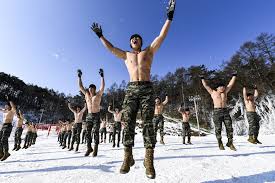GET BACK IN THE FIGHT WITH US!
START FROM THE BEGINNING – PREVIOUS DAY – NEXT DAY
Walking into the gym can be intimidating when you have certain limitations or injuries. Trust me, I know. I am a retired army ranger who has been rated by the military at 60% disabled. When I retired from the military in 2012, I felt broken. Overall I looked like I was in good shape, but I didn’t feel like I was. After spending 26 years beating up my body, I hurt. I was tired of working out and I decided to take a break from it for a couple of years. During this time, I developed an AMAZING “Dadbod.” But not only did I start to look worse, I started to feel worse. The aches and pains were getting greater and I knew I had to get back into the gym and start training again. But where do I start? I am now in worse shape than before and I have significant issues—I had degenerative back disease, bad knees and carpal tunnel in both wrists. However, I knew that I either had to start training to keep the injuries at bay or things would just get worse. It can be intimidating. I understand, trust me, I do. Luckily, my years of military taught me that the first thing that I needed was a plan. Walking into the gym and just using machines without even a simple plan is not a smart idea. You will probably won’t see results and you run the risk of injuring yourself.I needed to work around my limitations (lower back issues makes it very hard to do traditional back exercises) and because of the carpal tunnel, I cannot keep my grip on weights when doing certain lifts. I cannot do squats (or couldn’t when I first started lifting again) and lunges were out of the question.
Finding the right resources:
[caption id="attachment_9719" align="aligncenter" width="1024"]

Staff Sgt. Masgarede Isbrecht of the German Military and Capt. Judith Zelaya Clinical Nurse in Charge of Vilseck Health Clinic exchange a handshake in an emergency bus during the Medical Assistant Personnel Training Conference at the German Central Military Hospital in Koblenz, Germany on OCT 19, 2016. (U.S. Army Photo by Capt. Jerome C. Ferrin)[/caption]These days it’s so easy to get good advice via social media. I am a member of some bodybuilding groups on Facebook and Instagram. I was able to ask questions, talk to coaches and others who have the similar limitations and learned about various exercises that would help me work around what I can’t do, and allowed me to focus on alternative exercises that would allow me to strengthen the muscles in my lower back without injury. Well... without injury was the plan, but every once in a while I would either try to lift too heavy and throw my back out some or pull a muscle, but these were short-term injuries that I recovered from quickly. I found an online coach who saw what I was doing (I was documenting my challenges on Facebook) and he wanted to help. We had a few discussions and he then gave me a personalized routine that changed often to keep me from getting bored. This boost helped me start to gain momentum and slowly I gained back the body I used to have. The more I trained, the stronger I felt and the fewer issues I had with my back.

Supplements when lifting:
Supplements have their role when it comes to what I consider “rehabilitation. “ I believe in this to such a great extent that I now own a company that makes them. I wasn’t always motivated to go to the gym. On those days, I would use a pre-workout supplement to motivate me. On the days I lifted weights, I would add Glucosamine to my water because it helps with lactic acids (the pain that develops in your muscles after you tear them up by lifting) and it would allow me to be “less sore” the next day and I would recover quicker. I knew I had to increase my protein intake. Based on my weight, I would have to consume 300 grams of protein daily. There was no way could I eat 300 grams of protein a day, so I would supplement with protein shakes.Do you need to take supplements to work out? Absolutely not. I just know that for me, it helped me stay motivated and achieve my goals quicker.
Special Gym Gear:
[caption id="attachment_9718" align="aligncenter" width="1024"]

Soldiers from 3rd Infantry Division compete against each other during the CrossFit competition November 14, 2016 at Caro Gym at Fort Stewart for Marne Week. Soldiers throughout the Division are celebrating their 99th birthday with a week-long celebration known as Marne Week, Nov. 14-18.[/caption]Getting the correct clothing and safety equipment is paramount when working out with injuries. Here are the things I used to help me:
- Knee Guards—these are compression sleeves that I use when lifting heavy weights with my legs. They keep my knees from moving around and keep the injuries at bay. The one time I worked out without them I messed up my knee.
- Waist Belt—imperative to ensure my core would stay tight when doing any sort of shrugs or leg work. This is my trouble area, so I use the waist belt every time to make sure I keep back issues this in check.
- Wrist hooks—like I previously mentioned, I have carpel tunnel in both wrists. I am very strong but my poor grip prevents me from hanging on. Wrist hooks allow me to take the pressure off my grip so that I can lift heavier weight. I don’t wear them all the time, just when I know my grip strength cannot handle the weight I am trying to move.
Workout plan:
Write it down. Each time, every time! If you have a plan, you need to write it down and track it. I have seen people who work out in the gym and they look the same, year after year. Sure enough, those are the people do not have a journal or workout plan. How will you be able to know exactly how much weight you lifted during each exercise over a week ago? If you write it down, you can see exactly the weight and reps you did. Then I would use it as a guide to either try to increase the weight or increase the reps from last week. Truly, a workout plan was the greatest assist in helping me regain my strength and health. Whether you are looking to get back into the gym, or you just need some motivation to get off the couch, these steps can help you get back to the person you used to be, or even better than you used to be. About the Author: Scott Hardesty is a retired Army Ranger that served 26 years in the US Army. Despite being rated 60% disabled by the military, he successfully lost weight and gained muscle in just 10 months through hard work and dedication. He founded Ranger Nutrition as a way to provide people with the tools they need to get - and stay - in shape, with products made in the USA.




%201.svg)









